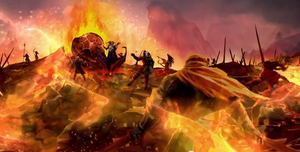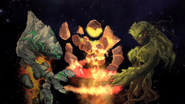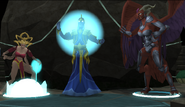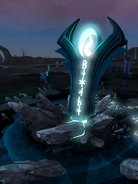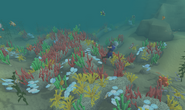m (Spelling) |
m (→Sixth Age: Changed map to png version) Tag: Visual edit |
||
| Line 79: | Line 79: | ||
[[File:Guthix's slaying.png|200px|thumb|right|Guthix is killed by Sliske, starting the Sixth Age.]] |
[[File:Guthix's slaying.png|200px|thumb|right|Guthix is killed by Sliske, starting the Sixth Age.]] |
||
The Sixth Age is the current and ongoing age in Gielinor. |
The Sixth Age is the current and ongoing age in Gielinor. |
||
| − | [[File:Gielinor region map. |
+ | [[File:Gielinor region map.png|200px|thumb|right|A map of Gielinor's regions during the Sixth Age.]] |
The Sixth Age started with [[Assassination of Guthix|Guthix's death]] at the hands of [[Sliske]], a powerful Zarosian Mahjarrat. This marked the end of the [[Edicts of Guthix]], and paved the way for the gods to return to Gielinor. This event also marked the creation of position of [[The World Wakes|World Guardian]]; Guthix gave a single human adventurer the authority of a [[Guardian of Guthix]] and a blessing, preventing other gods from influencing the adventurer through their divine powers. |
The Sixth Age started with [[Assassination of Guthix|Guthix's death]] at the hands of [[Sliske]], a powerful Zarosian Mahjarrat. This marked the end of the [[Edicts of Guthix]], and paved the way for the gods to return to Gielinor. This event also marked the creation of position of [[The World Wakes|World Guardian]]; Guthix gave a single human adventurer the authority of a [[Guardian of Guthix]] and a blessing, preventing other gods from influencing the adventurer through their divine powers. |
||
Revision as of 00:22, 6 November 2014
Template:RSC pageTemplate:2007 page
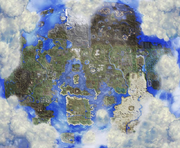
Gielinor, the Realm more commonly called RuneScape.
Gielinor (pronounced Gill-in-or), nicknamed RuneScape by the humans inhabiting it, is the world in which most of RuneScape takes place. It was the final creation of the Elder Gods, and was later discovered by the god Guthix in the First Age when he was exploring realms with the elder sword. Gielinor's most notable areas include Misthalin, Asgarnia, the Kharidian Desert, Kandarin, Karamja, Troll Country, the Fremennik Province, Tirannwn, Morytania, the Feldip Hills, the Wilderness, The North and the northern and southern seas. The demonym of Gielinor is Gielinorian.
Yes, he's created countless numbers of them, storing them all over the place; so, soon after their discovery, this world was dubbed RuneScape. We were initially calling it Gielinor but, like many things of importance, different people call it by different names.
Jack, Meeting History
Astronomical location

Gielinor as seen from orbit.

Night time on Gielinor.
Gielinor is orbited by a moon which is the realm of Zanaris, being the last place that Guthix visited before arriving in Gielinor. Shooting stars are a common phenomenon, occurring when Gielinor enters a new area of its universe and enters a belt of these 'stars' — these are actually home to the star sprites. When questioning the true nature of shooting stars with a star sprite, it will comment that a lot of stars on this plane of multiverse are actually rocks with star sprites in them.
Geography
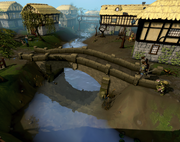
The River Lum.
Gielinor is a mixture of mountainous, barren, forested, volcanic, snowy and tropical areas. Most of its cities lie in kingdoms, and others on numerous islands. Much of Gielinor is lush with water resources, enabling the existence of vast rivers and seas. There is also a large, destroyed continent to the north called the Wilderness. Known continents of Gielinor are the Wushanko Isles and the Forinthry site, which is today called the Wilderness. Tropical areas lie to the south, while the north is cold and icy. The south-east is largely a barren desert, the far west is a dense taiga forest, and the far east has a humid, marshy climate.
History
Creation
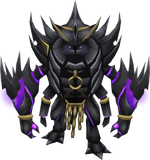
The Tokhaar.

Guthix arrives in Gielinor.
Gielinor was created by a quartet of Elder Gods Jas, Ful, Bik and Wen[1] very long ago[2]. It was their perfect and last creation. The TokHaar, a race created by them, were tasked to design the mountains of the world. They forged the Xil to dig up the earth and rock, the Mej to blast it into size that the Ket could carry, and the Hur to craft the sediment into cliff-faces and slopes[3]. This race is immortal, powerful, and directly dependent on the Elder Kiln.
Gielinor was rediscovered by Guthix when he was travelling between realms with the elder sword. He found it at the beginning of the First Age and believed it to be perfect, the land containing many Elder Artefacts. Guthix decided the planet had to be shared with mortals so he opened gateways allowing them to enter, reshaping the world in the process. Then he entered a long slumber so the mortals could enjoy the land without his presence. Those humans began to form the first civilisations and, after the arrival of Seren, the elves joined them. Later, other gods arrived and the Second Age started. During Meeting History it was discovered that Guthix hid runes throughout the land when he found Gielinor. This resulted in mortals calling the world RuneScape; a portmanteau of rune and landscape.
Second Age
| “ | Gielinor is a precious jewel in the looted treasury of the cosmos. | ” |
— Saradomin, explaining why Gielinor is so important to him.
|
The Second Age started after Guthix entered his slumber, with the arrival of other major gods like Zaros and Saradomin, who wanted to conquer Gielinor. During this time, Armadyl had his followers composed mainly of humans and Aviantese, Saradomin had mainly humans and Icyene under his control and Zaros had his followers composed of mainly Mahjarrat, Dragon Riders, demons, Auspah and humans. Zaros had the biggest and mightiest empire and was the most powerful active god. He had many expanding campaigns and between his targets was Saradomin's territory and the Kharidian Desert. At the peak of his empire, Zamorak, one of his most worthy generals betrayed him and managed to defeat him with the Staff of Armadyl's help, banishing him from Gielinor. After that, Zamorak was briefly banished by the other gods but soon returned and declared war against all the gods in order to compete Zaros' legacy with them, starting the Third Age.

Zaros is impaled by the Staff of Armadyl during the fight with Zamorak. Note that he was really stabbed in the back, not in the chest.
Third Age
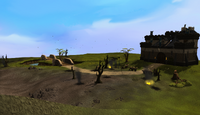
The Zarosian fortress of Annakarl, under Saradomin's control.
Near the end of the Second Age, the god Zaros was betrayed by his top general Zamorak and impaled by the Staff of Armadyl, transferring some of Zaros's power to Zamorak and later turning Zamorak into a god. Zaros was gone, but other gods wanted his lost achievements for themselves, such as his fortresses and settlements.
After several events that happened after Zaros' banishment, such as the banishment of Zamorak, the seizure of the Stone of Jas and the Staff of Armadyl by Saradomin and Armadyl, and the hunt for the Dragon Riders, Zamorak finally returned nineteen years later and declared the God Wars. The series of devastating campaigns and intense battles collectively known as the God Wars caused the extinction of many races and resulted in a war the likes of which had never been seen on the planet. The last event of the God Wars occurred when Zamorak finally had the Stone of Jas under his control. With its support, his powers were enhanced and he incinerated the entire continent of Forinthry.
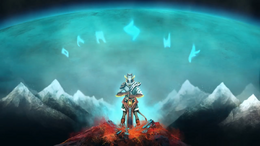
Guthix creates his Edicts, banishing all major gods from Gielinor.
The destruction was so intense that the Anima Mundi, the life force of Gielinor itself, cried out in pain and awoke Guthix. Guthix created the Edicts of Guthix, which banished all the major gods from Gielinor and prevented them from returning. After solving some matters like hiding the Stone of Jas again, Guthix entered his slumber once more so that mortals could enjoy Gielinor without gods, but not before weeping at the destruction and creating the Tears of Guthix.
Fourth Age
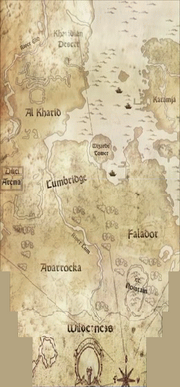
A partial map of Fourth Age Gielinor, from north to south.
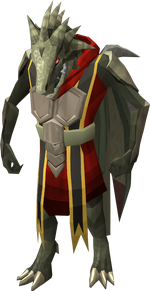
One of the Dragonkin.
The Fourth Age was marked by the absence of major gods, the reconstruction of settlements destroyed by the God Wars, the invasion of the Dragonkin, and the creation of many kingdoms. It lasted roughly 2,000 years.
At the very beginning of the Fourth Age, the Dragonkin invaded Gielinor due to the heavy use of the Stone of Jas during the God Wars and revealed themselves to be a true threat to other mortals. Having no gods to protect them, mortals rose and fought them by themselves, the most notable of these being Robert the Strong. He forced the Dragonkin back to their stronghold and became one of the most important heroes in Gielinor's history.
Also at the beginning of this age, a stone circle was built on Taverley as part of the security of Guthix's home, as revealed in The World Wakes quest. It is also used as a place of devotion to Guthix.
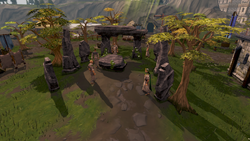
The Taverley stone circle.
Around the years 700 and 800 of the Fourth Age, a new hero named Arrav was gaining popularity in in the newly founded Avarrocka. He defended Avarrocka from the invasion of a very dangerous Mahjarrat named Zemouregal, who was seeking a very powerful shield, which became known as the Shield of Arrav, to use in his plans. After bravely fighting against Zemouregal, Arrav was stuck in the back by Zemouregal's sword, composed of smoke and shadow. After that, Zemouregal stood on his body and used ancient magic to kill him. Zemouregal disappeared with Arrav's body, and he would later use it to bring him back to life.
In the middle of this age, Seven Priestly Warriors drove back the evil creatures coming from Morytania and blessed the River Salve with the power of Saradomin, creating a protective barrier and making the west safe from them.[4]
At the end of the Fourth Age, in the year 1937, settlers established a town on the River Lum. Across the river, they built a bridge and hence the town was called Lumbridge.
Fifth Age
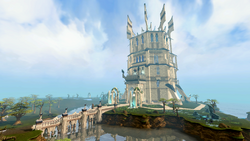
The Wizards' Tower, symbol of the Fifth Age's progress.
The Fifth Age is the shortest age of history; lasting only 169 years but with many important changes in the context of Gielinor, mainly consisting of the growing dominance of the humans.
In the first years of the Fifth Age, human mages discovered the rune essence, but kept their locations a closely guarded secret between a select few of them, so as not to let the information fall into enemy hands. They used the power of the essence and elemental altars they knew about to create various runes. Due to the power of the runes, humans started to become more significant within the world, and the human kingdoms of Misthalin and Asgarnia quickly grew to become some of Gielinor's most important kingdoms while the cities we know today like Varrock (Avarrocka) and Falador grew more influential, transitioning into their modern incarnations. The mages who discovered the runes created a great tower in southern Misthalin, which became known as Wizards' Tower. The first Wizards' Tower unfortunately was destroyed as a result of magical experimentation and the event used by Saradominists to marshal support against Zamorakians. Later in the age, a second Wizards' Tower would be built upon the ruins of the first, primarily by Saradominists out of suspicion of the followers of other gods. The knowledge of Runecrafting wouldn't be rediscovered until the end of the Fifth Age.
After many awful accidents involving magic, at the year 9 of the Fifth Age, the Mage Training Arena was built to properly guide the mages, who had just discovered magic and runecrafting, preventing further disasters.
During the twelfth year of the Fifth Age, Scorpius, an astrologer of the Fourth Age, built a gigantic telescope at the west to track the stars and predict the future, gaining dark knowledge. After some time, still in the early Fifth Age, his ways were rediscovered and the Observatory was restored.
In the year 47, the Fremennik, a tribe of humans who were extremely discontented with the practice of magic and runecrafting as they thought it was something to be used by gods and not mortals, destroyed the Mage Training Arena. The Mage Training Arena was later rebuilt but significant magical knowledge was lost. During the campaign, the Imcando Dwarves were left devastated and the Runecrafting Altars left in ruins, albeit still functional. The settlement of Gunnarsgrunn was also founded by the end of the campaign due to the invasion running out of steam and needing to regroup.
In the year 129, Crandor was annihilated when a Crandorian adventurer awoke a sleeping dragon called Elvarg who disposed of the adventurer before emerging from ground and razing the island kingdom to ash. Some survivors and refugees escaped via fishing boats all the way to the shores of Asgarnia near the town of Rimmington, but Elvarg followed them. Only three mages were known to have survived the destruction. Thirty years later, an adventurer slays Elvarg, finally avenging the people of Crandor.
Notable at the end of the Fifth Age is the thawing of the God Wars Dungeon and discovery of many powerful beings by adventurers; the consequence of this being their slow return to the world scene. Azzanadra, after being freed from his prison by an adventurer managed to re-establish contact with the god Zaros.
Sixth Age
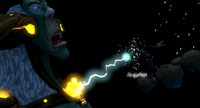
Guthix is killed by Sliske, starting the Sixth Age.
The Sixth Age is the current and ongoing age in Gielinor.
A map of Gielinor's regions during the Sixth Age.
The Sixth Age started with Guthix's death at the hands of Sliske, a powerful Zarosian Mahjarrat. This marked the end of the Edicts of Guthix, and paved the way for the gods to return to Gielinor. This event also marked the creation of position of World Guardian; Guthix gave a single human adventurer the authority of a Guardian of Guthix and a blessing, preventing other gods from influencing the adventurer through their divine powers.
Although Guthix died, his powers can still be seen; they are dissipating in the nature of Gielinor, causing strange events such as trees glowing with power, "crying" at his demise and butterflies propagating his power and distant memories.
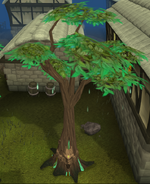
The Anima Mundi mourning Guthix's death.
After the Edicts of Guthix's undoing, Saradomin was the first god to have returned, followed by Zamorak which resulted in a small battle near Lumbridge. According to Wahisietel, the gods are first examining the situation of the context to create strategies before taking actions. Zaros for example, had abandoned his body in the brawl with Zamorak during the Second Age to avoid being annihilated and is currently looking for a host body to then put his plans in motion[5].
Sometime after, the reaper of souls, Harold Death, had gone missing and Ichthlarin, the Menaphite god of the dead and caretaker of the dead after Death delivers souls to him, began searching for Death. Ichthlarin soon realized that Death had been kidnapped by the Mahjarrat Sliske, and Sliske sent the World Guardian and Icthlarin an invitation to Sliske's ascension ceremony where he claimed he'd be able to claim godhood for his own. Icthlarin had no choice but to accept the invitation and teleported to the Empyrean Citadel, the former seat of power of Armadyl. Icthlarin is able to enter the grand hall, greeted by Saradomin, Zamorak, Bandos, and Armadyl; Seren had shattered her body as a crystal and has yet to return, Guthix's podium laid empty as a message to the other gods, Brassica Prime remained silent but was present, a mysterious energy floated above the podium intended for Zaros, and Marimbo was nowhere to be seen. The World Guardian however was not able to enter the grand hall and was forced to run a gauntlet of challenges set up by Sliske. Sliske showed up just as the gods were on the brink of losing their tempers and revealed that he had captured both Death and Strisath, one of the Dragonkin. To ensure the gods did not attack him, he threatened to kill Death itself, or release Strisath after claiming "He seems to have increased in power lately." Sliske then revealed that there was no ascension, and explained how he found the Stone of Jas by use of the Staff of Armadyl after trapping Strisath in the Shadow Realm with the other half of the staff. Sliske then made a proposal: a competition to reward whoever kills the most gods with the Stone of Jas as the reward. Sliske releases Strisath and Death is freed, but succeeds in initiating fear of a second war of the gods.
Immediately after Sliske initiates the Sixth Age God Wars, Bandos turned to the newly discovered skill of Divination, planning to use a weapon of mass destruction powered by divine energy called the Scarecrow to destroy the god with a viewpoint most opposed of his own, Armadyl. Armadyl retaliates by making a weapon of mass destruction of his own, the Divine Focus. To gather energy, they sent out caravans while followers and adventurers fought a hit-and-run ground war across Asgarnia and Misthalin. Bandos lost the battle and became the first victim of Sliske's grand scheme.
During the Sixth Age, Zaros returned to Gielinor with the aid of the World Guardian. Zaros reveals his history and his future aspirations and plans to the World Guardian before he assigned his most faithful followers on individual missions. Zaros, now in corporeal form is currently observing world events and the other gods from the Shadow Realm. Sliske is now excommunicated from the following of Zaros officially, and now is rogue, targeting the World Guardian. The World Guardian also now holds an Elder Artefact called The Measure and can permanently see into the Shadow Realm; the latter, a gift from Sliske who has grown even more powerful.
Notable to include is the arrival of a new race on Gielinor called the Airut and the growing knowledge collected by seasoned adventurers and Slayer Masters of the approaching arrival of a new god named Tuska.
See also
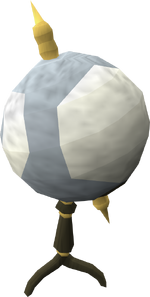
A globe of Gielinor.
- A map of Gielinor.
- The History of RuneScape.
- The different Locations in Gielinor.
- Scale Theory, used to explain inconsistencies between plot and game.
- For alternate planes of existence see:
- ScapeRune: A possible alternate reality to that of RuneScape.
- Yu'biusk: The original homeland of the Goblins, Orks, Ourgs, Raurgs and Fayrgs.
- Shadow Realm: A type of realm mentioned during The General's Shadow miniquest and shown by Sliske during The World Wakes.
- Spirit Realm: A parallel plane to the Wilderness of Gielinor.
- Zanaris: The realm of the fairies and moon of Gielinor.
- Land of Snow: An icy realm created by Guthix to balance the heat of Gielinor.
- Fisher Realm: A strange realm, mostly accessed during the quest The Holy Grail.
- Interdimensional Rift: An electric-based realm, accessible by a portal on the top floor of Draynor Manor.
- Primordial Realm: The location of the activity Stealing Creation.
- Abyss: Contains rifts to every Runecrafting altar in Gielinor.
- Dream World: A realm of dreams where the quests Lunar Diplomacy and Dream Mentor take place in.
- Puro-Puro: The magical realm of the implings.
- Cosmic Plane: Home to the rare starflowers. It is only accessible via the fairy ring system.
- Gorak Plane: A dimension inhabited by Goraks. It is only accessible via the fairy ring system.
- Enchanted Valley: A beautiful place that is home to several unique creatures including wood dryads and centaurs.
- Fremennik spiritual realm: The paradise of Fremenniks, they arrive there when they die.
Gallery
Trivia
- "Gielinor" is an anagram for religion.
- It takes approximately 15 minutes to run from Port Phasmatys in the east to Port Tyras in the west and 30 minutes to walk from Mobilising Armies to Port Phasmatys.
References
| Supradimensional | |
| Realms and worlds | |


